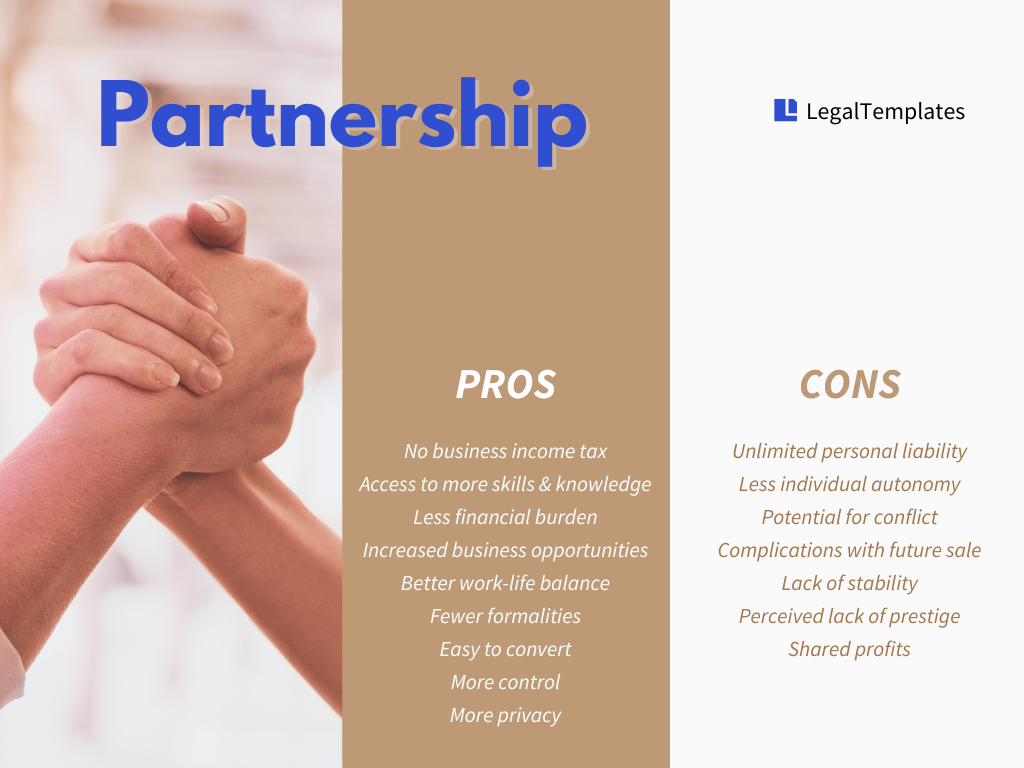
A partnership is an unincorporated relationship between two or more individuals working together to progress mutual business interests.
Similar to a sole proprietorship, forming a partnership does not require establishing a business entity legally separate from the founders (though some states require partnership registration). In a partnership, each member contributes an investment of some form (money, property, labor, skills, contacts, etc.) and shares in the profits and losses of the business.
Before you and your partners sign the dotted line on your partnership agreement, it’s important that you first understand the advantages and disadvantages of business partnerships.Table of Contents
10 Advantages of a Partnership
Forming a partnership presents unique advantages that can affect every aspect of your business — from finances and taxes to work-life balance and productivity.

1. No Additional Businesses Taxes
Although partnerships must file information with the IRS about their annual financial performance (revenue, profits, losses, gains, etc.), they don’t have to pay income tax at a business level.
Instead, a partnership “passes through” any profits — or losses — to the individual partners. In turn, all partners must include their share of profits or losses incurred by the business on their tax returns.
2. Access to Complementary Skills and Knowledge
A partnership can provide access to essential skills and experience — especially in areas you personally lack. Most successful partnerships work well because partners have complementary skill sets and help each other fill gaps in expertise.
For example, you may be experienced in sales and business development, whereas your other partners might be certified accountants or expert marketers.
3. Less Financial Burden
Overhead expenses are among the biggest challenges of building a new business. Sharing startup costs and other expenses with business partners is an attractive aspect of a partnership.
Additionally, having multiple partners enhances the company’s borrowing capacity as the risk is distributed among partners. Banks and other financial institutions are more inclined to extend credit to partnerships than to sole proprietorships.
4. Increased Business Opportunities
If your business partner is financially strong, they can help get more funding and cash for your business to explore new business opportunities. If your partners are experienced, they usually have important industry and community contacts that can benefit your business.
5. Better Work-Life Balance
A partner can help you shoulder a new business’s workload and other responsibilities. In this way, having a partner can improve your work–life balance — which studies have shown leads to increased productivity.
6. A Second Perspective
Business owners often get tunnel vision, focusing only on immediate challenges and missing out on potential solutions. A partner not only brings a fresh set of eyes but also their unique experiences and ideas, which can be invaluable.
This diversity in thought and approach can lead to innovative solutions and significant growth, helping your business evolve in ways you might not have imagined.
7. Fewer Formalities and Obligations
Unlike limited liability companies and corporations, some states do not require partnerships be registered with the Secretary of State. Most states legally recognize partnerships once they begin business operations.
There are also fewer ongoing requirements to comply with. For example, all LLCs are required to have a registered agent (which incurs costs yearly), and most states require LLCs to submit annual or biennial reports with a filing fee ranging from tens to hundreds of dollars. However, if your state does not require a business partnership to be registered, it requires minimal maintenance.
8. Easy to Convert to Other Business Structures
If you decide you need more protection for your business later on, converting your partnership into a limited liability company is fairly straightforward due to their similar structures of shared decision-making and flexible management.
The process is not overly complex, with most states providing clear guidelines and forms. These steps are manageable for partners experienced in handling business documentation.
9. More Control
While the operator of a limited company or corporation might be subject to the demands of shareholders or a board of directors, a business partnership involves more freedom. Members answer only to one another and don’t need to worry about external decision-makers.
10. Privacy and Confidentiality
Partnerships aren’t required to disclose their financial and organizational information publicly. Companies and corporations, on the other hand, must make this information available to the IRS and shareholders.
For example, a publicly traded company must distribute an annual report to its shareholders and post it on its website for the public to view.
7 Disadvantages of a Partnership
While partnerships enjoy certain freedoms, there are disadvantages as well. The disadvantages of a partnership highlight why selecting a trustworthy partner is vital.
1. Increased Liability
One of the major disadvantages of a general partnership is the equal liability of each partner for losses and debts.
Each partner has an unlimited personal liability, which means every partner is responsible for any bad business dealings the partnership enters into. Every decision your partner makes has potential consequences for your assets and finances.
For example, if the business has been unprofitable and you can’t make payments on a loan your partner took out, creditors might sue you and take your personal assets such as bank accounts, cars, and houses.
2. Less Autonomy
Partners have equal decision-making power (unless otherwise specified in the partnership agreement). Most decisions are made jointly, so you sometimes have to compromise.
To avoid this issue, some partners decide to allow each individual partner have the sole authority to make decisions on behalf of the partnership on specific subjects (e.g. hiring; borrowing money).
3. Potential for Conflict
Partnerships, like most relationships, can quickly become complicated when associates disagree. This is especially true if there are only two partners without anyone else as a tie-breaker in a disagreement.
It’s important to outline how disputes will be solved in your partnership agreement.
4. Complications with Future Sale
When forming a partnership business, work an exit strategy into the documentation. Issues can arise when one partner wants to sell and the other doesn’t.
Typically, if an associate is interested in leaving the partnership, they use an assignment of partnership interests to transfer the right to receive benefits to a new partner. However, this can introduce a range of complications that affect the dynamics within the business.
The existing partners may not have an existing working relationship with the new partner, who could be a complete stranger to the team. Differences in work ethic, management style, and business philosophies between the existing partners and the new partner can create friction.
If that’s something you’d like to avoid, make sure your partnership agreement contains the right of first refusal so that the original partners have a right to purchase the interest before an outside party.
► READ MORE: How to Transfer Business Ownership
5. Lack of Stability
Partnerships, known for their flexibility, lack the inherent stability of incorporated organizations. The business’s reliance on its partners means that life events like death, birth, illness, or departures can significantly impact its operations.
Under the Uniform Partnership Act (UPA), a partnership may dissolve (under some state laws) if a member leaves, unless there’s an agreement to continue.
Make sure you discuss with your parnter how to handle such life events and address them clearly in the agreement.
6. Perceived Lack of Prestige
For many, a formal business entity structure is a sign of prestige. While some informality can be attractive for those involved in the organization, it can worry investors looking to put money in or collaborate with the business.
7. Shared Profits
Partners must share profits like they share labor and overhead expenses. While a partner means more opportunity to generate increased revenue, it also means that revenue must be shared according to the terms of the agreement.
Do the Benefits Outweigh the Drawbacks?
Choosing the right business structure for you and your business can be challenging. There are some distinct advantages a partnership can bring— freedom and flexibility being chief among them.
On the other hand, choosing a limited company or corporation business structure can help you avoid the associated disadvantages, such as the unlimited liability you bear as an individual.
Having a well-drafted partnership agreement is essential in minimizing potential issues a partnership may have. Join over 500,000 monthly users and create your partnership agreement with us
.
Mollie Moric
Legal Content Writer
Mollie Moric is a staff writer at Legal Templates. She translates complex legal concepts into easy to understand articles that empower readers in their legal pursuits. Her legal advice and analysis…